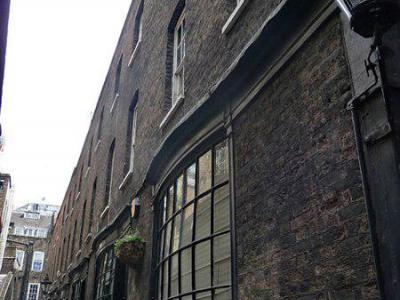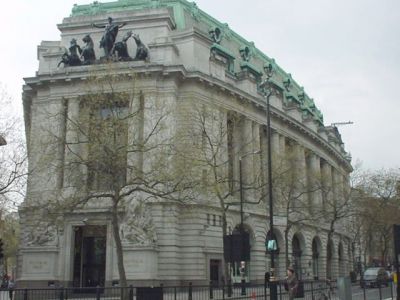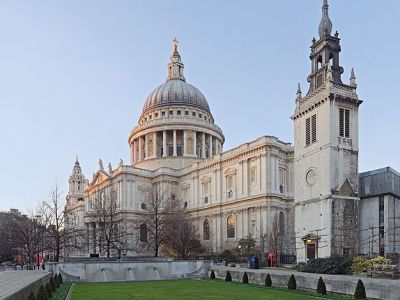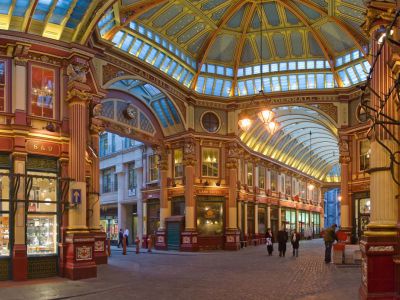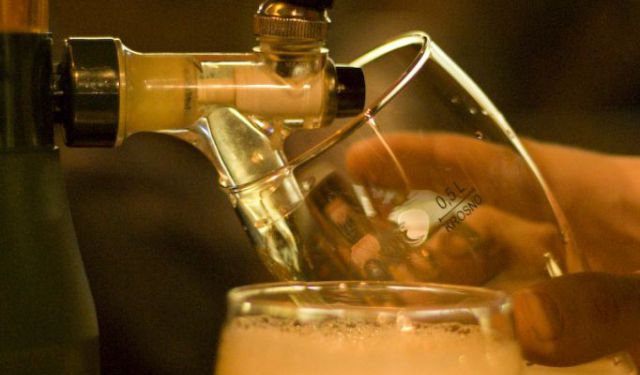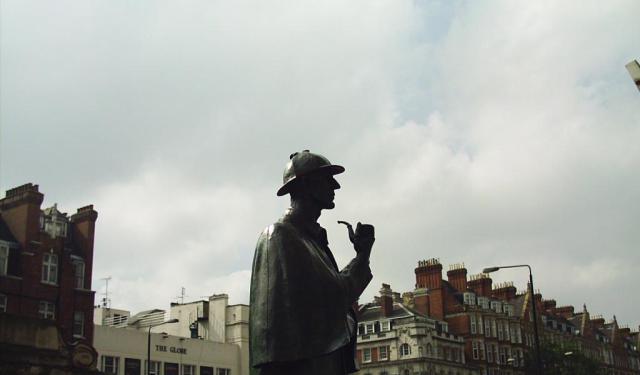
Harry Potter Walking Tour II (Self Guided), London
The arrival of Harry Potter books, followed by tremendously successful Hollywood adaptation, has made London an even more popular destination now with the Harry Potter fans all over the world. The list of attractions in the city associated with Potter’s journeys includes both, newly-invented as well as some long-standing locations.
On Part II of the self-guided Happy Potter Walking Tour, you will continue your journey in the footsteps of Harry Potter and his friends by visiting several memorable filming sites including Australia House ("Gringotts Bank"), St. Paul's Cathedral (“Divination Stairwell”), Leadenhall Market ("Bull’s Head Passage"), and more.
On Part II of the self-guided Happy Potter Walking Tour, you will continue your journey in the footsteps of Harry Potter and his friends by visiting several memorable filming sites including Australia House ("Gringotts Bank"), St. Paul's Cathedral (“Divination Stairwell”), Leadenhall Market ("Bull’s Head Passage"), and more.
How it works: Download the app "GPSmyCity: Walks in 1K+ Cities" from Apple App Store or Google Play Store to your mobile phone or tablet. The app turns your mobile device into a personal tour guide and its built-in GPS navigation functions guide you from one tour stop to next. The app works offline, so no data plan is needed when traveling abroad.
Harry Potter Walking Tour II Map
Guide Name: Harry Potter Walking Tour II
Guide Location: England » London (See other walking tours in London)
Guide Type: Self-guided Walking Tour (Sightseeing)
# of Attractions: 6
Tour Duration: 2 Hour(s)
Travel Distance: 4.1 Km or 2.5 Miles
Author: felicity
Sight(s) Featured in This Guide:
Guide Location: England » London (See other walking tours in London)
Guide Type: Self-guided Walking Tour (Sightseeing)
# of Attractions: 6
Tour Duration: 2 Hour(s)
Travel Distance: 4.1 Km or 2.5 Miles
Author: felicity
Sight(s) Featured in This Guide:
- Goodwin’s Court
- Australia House
- Blackfriars Bridge
- Millennium Bridge
- St. Paul's Cathedral
- Leadenhall Market
1) Goodwin’s Court
In the Covent Garden area of London, you'll come across numerous narrow alleys adorned with small storefronts. Among these lesser-known and tucked-away passages lies Goodwin's Court, a dark and slender alley that's discreetly incorporated into the facade of The Theatre Goers Club of Great Britain and conveniently located just a short distance from Cecil Court and Charing Cross Road. Stepping into this charming court, which dates back to around 1627, is like taking a journey back in time to the Georgian era, evident in the characteristic bow-fronted windows (remnants of the previous row of shops), glossy black doors adorned with gleaming knockers and brass knobs, and brass plates bearing the names of the businesses that occupy the space.
In the world of Harry Potter films, this place is very reminiscent of Diagon Alley, although, depending on the weather and lighting, it can even evoke a sense of its creepy evil twin, the Knockturn Alley. A stroll through Goodwin's Court is well worth it, if only to witness the authentic street lanterns and darkly painted structures that inspired the props created by Warner Brothers for the Harry Potter movies. Although you won't find wizarding books, robes, or wands here, the eerie resemblance between the black bay windows of Goodwin's Court and the film set is uncanny. It might just send shivers down your spine as you imagine encountering characters like Bellatrix Lestrange or Lucius Malfoy apparating in the dead of night!
In the world of Harry Potter films, this place is very reminiscent of Diagon Alley, although, depending on the weather and lighting, it can even evoke a sense of its creepy evil twin, the Knockturn Alley. A stroll through Goodwin's Court is well worth it, if only to witness the authentic street lanterns and darkly painted structures that inspired the props created by Warner Brothers for the Harry Potter movies. Although you won't find wizarding books, robes, or wands here, the eerie resemblance between the black bay windows of Goodwin's Court and the film set is uncanny. It might just send shivers down your spine as you imagine encountering characters like Bellatrix Lestrange or Lucius Malfoy apparating in the dead of night!
2) Australia House
Just beyond Bush House, which once served as the home of the BBC's World Service, you'll find Australia House. This building, essentially an embassy for Australia within the British Commonwealth, was officially opened by King George V in 1918.
Yet, for devoted Harry Potter fans, this is more than just an embassy; it's firmly linked to Gringotts Bank, the exclusive financial institution of the wizarding world owned and operated by goblins. In J.K. Rowling's books, Gringotts' main offices are situated in North Side, Diagon Alley. Rubeus Hagrid even claims that, aside from Hogwarts School of Witchcraft and Wizardry, Gringotts is the safest place in the entire wizarding realm. The bank played a significant role in "Harry Potter and the Philosopher's Stone" and "Harry Potter and the Deathly Hallows – Part 2." The filmmakers not only filmed within the actual Australia House location but also replicated it at Leavesden Studios.
The lavish Beaux Arts interior of Australia House, adorned with marble and colossal glass chandeliers, served as an ideal backdrop for Gringotts, offering the desired grandeur that contrasted perfectly with the bank's goblin inhabitants. Normally serving as the High Commission, it is not typically open to the public, requiring a valid reason such as official business, like visa applications, migration inquiries, or citizenship matters, for entry. However, if you approach the security guards politely, they may permit you to discreetly glimpse inside the chandeliered room where filming took place. Bear in mind that Australia House is only open on weekdays, so if you visit on a weekend or public holiday, you won't be able to view the interior.
Tip:
The building sits on a multibranched intersection where the flow of traffic can be quite impressive to observe.
Yet, for devoted Harry Potter fans, this is more than just an embassy; it's firmly linked to Gringotts Bank, the exclusive financial institution of the wizarding world owned and operated by goblins. In J.K. Rowling's books, Gringotts' main offices are situated in North Side, Diagon Alley. Rubeus Hagrid even claims that, aside from Hogwarts School of Witchcraft and Wizardry, Gringotts is the safest place in the entire wizarding realm. The bank played a significant role in "Harry Potter and the Philosopher's Stone" and "Harry Potter and the Deathly Hallows – Part 2." The filmmakers not only filmed within the actual Australia House location but also replicated it at Leavesden Studios.
The lavish Beaux Arts interior of Australia House, adorned with marble and colossal glass chandeliers, served as an ideal backdrop for Gringotts, offering the desired grandeur that contrasted perfectly with the bank's goblin inhabitants. Normally serving as the High Commission, it is not typically open to the public, requiring a valid reason such as official business, like visa applications, migration inquiries, or citizenship matters, for entry. However, if you approach the security guards politely, they may permit you to discreetly glimpse inside the chandeliered room where filming took place. Bear in mind that Australia House is only open on weekdays, so if you visit on a weekend or public holiday, you won't be able to view the interior.
Tip:
The building sits on a multibranched intersection where the flow of traffic can be quite impressive to observe.
3) Blackfriars Bridge
In 1769, the first Blackfriars Bridge was inaugurated, bearing the creative touch of Robert Mylne, a talented Scottish architect who was just 26 years old at the time. Having honed his architectural skills in Rome, Mylne's design for the bridge drew inspiration from Piranesi, resulting in an elegant and classically designed construction featuring nine semi-elliptical arches crafted from Portland stone. This picturesque bridge, set against the backdrop of St. Paul's Cathedral, served as the subject of numerous 18th-century oil paintings, including William Marlow's renowned portrayal of Saint Paul's from the South Bank, which he completed in the early 1770s.
On November 6, 1869, Queen Victoria inaugurated the current Blackfriars Road Bridge, almost precisely a century after the opening of its predecessor, which had suffered irreparable masonry damage. This modern road bridge boasts five elliptical wrought-iron arches, the pioneering use of such a design aimed at avoiding cross-currents and disrupting river traffic. Towering granite piers, resembling pulpits, serve as a tribute to the ancient 13th-century Dominican monastery from which the bridge derives its name. The construction is adorned with a palette of red, white, and gold, featuring golden emblems embedded into its supports. It is said to mark the tidal turning point and is adorned with images of seabirds on the east (downstream) side and freshwater birds on the west (upstream) side. Additionally, the bridge signifies the boundary of the historic City of London, with a silver dragon statue guarding its southern landing.
In 1910, the bridge underwent expansion to accommodate trams and the increasing volume of traffic. With some 54,000 vehicles crossing it daily and spanning 105 feet, it now ranks as the widest bridge spanning the Thames in London.
Tip:
One can still observe Robert Mylne's original design depicted on decorative tiles inside the bridge's southern pedestrian subway.
***HARRY POTTER MOVIE***
Blackfriars Bridge appeared in the 2007 movie "Harry Potter and the Order of the Phoenix". It was featured in a scene where the members of the Order of the Phoenix flew beneath it during their journey from number 4, Privet Drive, to Grimmauld Place.
On November 6, 1869, Queen Victoria inaugurated the current Blackfriars Road Bridge, almost precisely a century after the opening of its predecessor, which had suffered irreparable masonry damage. This modern road bridge boasts five elliptical wrought-iron arches, the pioneering use of such a design aimed at avoiding cross-currents and disrupting river traffic. Towering granite piers, resembling pulpits, serve as a tribute to the ancient 13th-century Dominican monastery from which the bridge derives its name. The construction is adorned with a palette of red, white, and gold, featuring golden emblems embedded into its supports. It is said to mark the tidal turning point and is adorned with images of seabirds on the east (downstream) side and freshwater birds on the west (upstream) side. Additionally, the bridge signifies the boundary of the historic City of London, with a silver dragon statue guarding its southern landing.
In 1910, the bridge underwent expansion to accommodate trams and the increasing volume of traffic. With some 54,000 vehicles crossing it daily and spanning 105 feet, it now ranks as the widest bridge spanning the Thames in London.
Tip:
One can still observe Robert Mylne's original design depicted on decorative tiles inside the bridge's southern pedestrian subway.
***HARRY POTTER MOVIE***
Blackfriars Bridge appeared in the 2007 movie "Harry Potter and the Order of the Phoenix". It was featured in a scene where the members of the Order of the Phoenix flew beneath it during their journey from number 4, Privet Drive, to Grimmauld Place.
4) Millennium Bridge
The Millennium Bridge boasts three noteworthy distinctions: it stands as the Thames River's newest crossing, serves as London's exclusive pedestrian-only bridge, and has earned a place in history for having the shortest duration of operation before closure, shutting just two days after its grand inauguration.
The bridge was conceptualized to coincide with the year 2000, symbolizing the dawn of the 21st century. In 1996, Southwark Council conducted a competition, inviting architects from around the globe to devise a new structure that would embody the spirit of the new era. The winning designs, submitted by Foster & Partners and Ove Arup & Partners, marked the commencement of construction in 1998.
This strikingly contemporary suspension bridge spans a length of 325 meters and is supported by eight suspension cables intentionally positioned low to preserve unobstructed views of Saint Paul's Cathedral and Tate Modern. These cables are precisely tensioned to exert a formidable 2000-ton force against the sturdy piers rooted on each bank.
The bridge was formally inaugurated by Queen Elizabeth II and originally opened its gates in 2000. However, an unforeseen oscillation, brought about by the immense pedestrian throng (comprising 90,000 individuals) on its opening days, earned it the 'Wobbly Bridge' moniker. This issue was rectified by retrofitting 37 fluid-viscous dampers, designed to dissipate energy and control horizontal movement, as well as installing 52 tuned mass dampers to regulate vertical movement. Consequently, the bridge was reinstated in 2002 and has since remained free from significant vibrational disturbances.
***HARRY POTTER MOVIE***
It might have been this bridge's association with instability that led the filmmakers to depict it as a target of Death Eaters in the film adaptation of "Harry Potter and the Half-Blood Prince", deviating from the book where the Brockdale Bridge suffers a similar fate. Thankfully, despite its dramatic destruction in the harrowing opening scene of the film, where it snaps and crumbles as Death Eaters wreak havoc across London, the now iconic Millennium Bridge was not harmed during filming and you can safely walk on it today.
Why You Should Visit:
An excellent connection between the Tate Modern and Globe Theatre on one side and Saint Paul's Cathedral on the other, making it highly convenient for those exploring both riverbanks. This pedestrian-only bridge offers a delightful walking experience, with the cathedral serving as a picturesque backdrop.
Tip:
Wear comfortable shoes. Take an umbrella or a rain-proof jacket, just in case.
Also, note the paintings or stickers that are on the floor of the bridge.
The bridge was conceptualized to coincide with the year 2000, symbolizing the dawn of the 21st century. In 1996, Southwark Council conducted a competition, inviting architects from around the globe to devise a new structure that would embody the spirit of the new era. The winning designs, submitted by Foster & Partners and Ove Arup & Partners, marked the commencement of construction in 1998.
This strikingly contemporary suspension bridge spans a length of 325 meters and is supported by eight suspension cables intentionally positioned low to preserve unobstructed views of Saint Paul's Cathedral and Tate Modern. These cables are precisely tensioned to exert a formidable 2000-ton force against the sturdy piers rooted on each bank.
The bridge was formally inaugurated by Queen Elizabeth II and originally opened its gates in 2000. However, an unforeseen oscillation, brought about by the immense pedestrian throng (comprising 90,000 individuals) on its opening days, earned it the 'Wobbly Bridge' moniker. This issue was rectified by retrofitting 37 fluid-viscous dampers, designed to dissipate energy and control horizontal movement, as well as installing 52 tuned mass dampers to regulate vertical movement. Consequently, the bridge was reinstated in 2002 and has since remained free from significant vibrational disturbances.
***HARRY POTTER MOVIE***
It might have been this bridge's association with instability that led the filmmakers to depict it as a target of Death Eaters in the film adaptation of "Harry Potter and the Half-Blood Prince", deviating from the book where the Brockdale Bridge suffers a similar fate. Thankfully, despite its dramatic destruction in the harrowing opening scene of the film, where it snaps and crumbles as Death Eaters wreak havoc across London, the now iconic Millennium Bridge was not harmed during filming and you can safely walk on it today.
Why You Should Visit:
An excellent connection between the Tate Modern and Globe Theatre on one side and Saint Paul's Cathedral on the other, making it highly convenient for those exploring both riverbanks. This pedestrian-only bridge offers a delightful walking experience, with the cathedral serving as a picturesque backdrop.
Tip:
Wear comfortable shoes. Take an umbrella or a rain-proof jacket, just in case.
Also, note the paintings or stickers that are on the floor of the bridge.
5) St. Paul's Cathedral (must see)
For centuries, this iconic structure has symbolized London's enduring spirit of survival and rejuvenation, captivating visitors both inside and outside its grand walls. Sir Christopher Wren embarked on the design of the present-day cathedral in 1666, immediately following the destruction of the prior medieval building, founded in 1087, during the Great Fire. This historical context is evident in the inscription "resurgam" ("I shall rise again") on the pediment of the south entrance. Saint Paul's Cathedral once more became a symbol of the city's resilience during the Blitz, as local volunteers bravely fought to extinguish a fire on the dome (though despite their efforts, a significant portion of the building's eastern end and its high altar were lost). It has frequently served as the backdrop for momentous state events, including Winston Churchill's funeral and the wedding of Prince Charles and Princess Diana.
Construction commenced in 1675 and took 35 years to complete. Interestingly, this was Wren's third architectural proposal: the initial design was rejected for being too modern, while the second was deemed too modern and too influenced by Italian (Catholic) architecture. The "Great Model" of this second design, a 20-foot representation, can be seen in the crypt. In a compromise with the Anglican clergy, Wren included a traditional English spire but ultimately installed a neoclassical triple-layered dome, the second-largest cathedral dome globally after Saint Peter's in Rome.
The cathedral's interior showcases a remarkable example of English Baroque design. Ascend 257 steps up the meticulously engineered Geometric Staircase, a stone spiral marvel, to reach the Whispering Gallery, named so because a whisper against one wall can be heard clearly on the wall 112 feet away. Another 119 steps lead to the Stone Gallery, encircling the dome's exterior and offering panoramic views of London. For those with a head for heights, an additional 152 steps lead to the small Golden Gallery, an observation deck at the dome's zenith. At 278 feet above the cathedral floor, it presents even more breathtaking vistas.
Descending to ground level, in the south choir aisle, rests the grave of John Donne, the poet who served as dean of Saint Paul's from 1621 until his passing in 1631. His marble effigy stands as the cathedral's oldest surviving memorial and one of the few to endure the Great Fire. The intricately carved figures on the nearby choir stall are the creations of master carver Grinling Gibbons, who also adorned Wren's great organ. Behind the high altar lies the American Memorial Chapel, dedicated to the 28,000 American GIs stationed in the UK during the Second World War. Notable figures interred in the crypt include the Duke of Wellington, Admiral Lord Nelson, Sir Joshua Reynolds, Henry Moore, and Wren himself. Aptly, the Latin epitaph above Wren's tomb reads, "Reader, if you seek his monument, look around you."
***CHARLES DICKENS TOUR***
Saint Paul's serves as a prominent backdrop in many of Dickens' novels. In "Master Humphrey’s Clock", for instance, he portrays Master Humphrey ascending to the summit of the cathedral, then the tallest structure in London, to relish the sweeping panorama of the city. He writes, "Draw but a little circle above the clustering house tops, and you shall have within its space, everything with its opposite extreme and contradiction, close beside." Another Dickens work, "David Copperfield", takes Peggotty to the top of Saint Paul's to savor the impressive views over London, a practice that visitors continue to enjoy to this day.
The vicinity surrounding this iconic cathedral was intimately known to Dickens, and he frequently visited for various reasons, including attendance at significant public events such as the Duke of Wellington's funeral in 1852.
***SHAKESPEARE WALK***
During Shakespeare's era, the vicinity around Saint Paul's was quite distinct from its present appearance. Beyond serving as the hub of religious, political, cultural, and social activity in the city, the Cathedral also played a pivotal role in London's book trade, significantly impacting the literary creations of that time. By the year 1600, Shakespeare had become the most widely published professional playwright, and the earliest versions of his plays, such as "Titus Andronicus", "Richard II", "Much Ado About Nothing", and "The Merchant of Venice", were all bought and sold in the vicinity of Saint Paul's Churchyard. It is highly probable that Shakespeare himself frequented the local bookstores in search of materials that could serve as source material for his own works. To a considerable extent, the atmosphere around Saint Paul's influenced the Bard's writing and played a significant role in its survival and reception.
***HARRY POTTER MOVIE***
Other than architecture and history buffs, nowadays Harry Potter fans also have their reason to visit Saint Paul's. The focal point of their interest lies is the spectacular spiral Geometric Staircase (also referred to as the Dean's Stair) that creates the illusion of floating out from the walls of the Cathedral's South West Bell Tower. Recognizable from "Harry Potter and the Prisoner of Azkaban", this winding staircase served as the pathway for students ascending the stone steps on their way to Professor Trelawney's Divination classes, which were held in a classroom situated atop one of Hogwarts' North Towers. Additionally, the same staircase was featured in "Harry Potter and the Goblet of Fire" as the Turris Magnus staircase. To catch a glimpse, you'll need to enter the Cathedral with a visitor ticket.
Why You Should Visit:
An architectural marvel and an iconic representation of London.
There's a wealth of exploration to be had, whether you venture above ground or into the crypt.
Tip:
Entrance to this cathedral requires a fee. Opt for online ticket purchase to streamline your visit and save time.
Additionally, you have the option to purchase an audio tour at the entrance.
Construction commenced in 1675 and took 35 years to complete. Interestingly, this was Wren's third architectural proposal: the initial design was rejected for being too modern, while the second was deemed too modern and too influenced by Italian (Catholic) architecture. The "Great Model" of this second design, a 20-foot representation, can be seen in the crypt. In a compromise with the Anglican clergy, Wren included a traditional English spire but ultimately installed a neoclassical triple-layered dome, the second-largest cathedral dome globally after Saint Peter's in Rome.
The cathedral's interior showcases a remarkable example of English Baroque design. Ascend 257 steps up the meticulously engineered Geometric Staircase, a stone spiral marvel, to reach the Whispering Gallery, named so because a whisper against one wall can be heard clearly on the wall 112 feet away. Another 119 steps lead to the Stone Gallery, encircling the dome's exterior and offering panoramic views of London. For those with a head for heights, an additional 152 steps lead to the small Golden Gallery, an observation deck at the dome's zenith. At 278 feet above the cathedral floor, it presents even more breathtaking vistas.
Descending to ground level, in the south choir aisle, rests the grave of John Donne, the poet who served as dean of Saint Paul's from 1621 until his passing in 1631. His marble effigy stands as the cathedral's oldest surviving memorial and one of the few to endure the Great Fire. The intricately carved figures on the nearby choir stall are the creations of master carver Grinling Gibbons, who also adorned Wren's great organ. Behind the high altar lies the American Memorial Chapel, dedicated to the 28,000 American GIs stationed in the UK during the Second World War. Notable figures interred in the crypt include the Duke of Wellington, Admiral Lord Nelson, Sir Joshua Reynolds, Henry Moore, and Wren himself. Aptly, the Latin epitaph above Wren's tomb reads, "Reader, if you seek his monument, look around you."
***CHARLES DICKENS TOUR***
Saint Paul's serves as a prominent backdrop in many of Dickens' novels. In "Master Humphrey’s Clock", for instance, he portrays Master Humphrey ascending to the summit of the cathedral, then the tallest structure in London, to relish the sweeping panorama of the city. He writes, "Draw but a little circle above the clustering house tops, and you shall have within its space, everything with its opposite extreme and contradiction, close beside." Another Dickens work, "David Copperfield", takes Peggotty to the top of Saint Paul's to savor the impressive views over London, a practice that visitors continue to enjoy to this day.
The vicinity surrounding this iconic cathedral was intimately known to Dickens, and he frequently visited for various reasons, including attendance at significant public events such as the Duke of Wellington's funeral in 1852.
***SHAKESPEARE WALK***
During Shakespeare's era, the vicinity around Saint Paul's was quite distinct from its present appearance. Beyond serving as the hub of religious, political, cultural, and social activity in the city, the Cathedral also played a pivotal role in London's book trade, significantly impacting the literary creations of that time. By the year 1600, Shakespeare had become the most widely published professional playwright, and the earliest versions of his plays, such as "Titus Andronicus", "Richard II", "Much Ado About Nothing", and "The Merchant of Venice", were all bought and sold in the vicinity of Saint Paul's Churchyard. It is highly probable that Shakespeare himself frequented the local bookstores in search of materials that could serve as source material for his own works. To a considerable extent, the atmosphere around Saint Paul's influenced the Bard's writing and played a significant role in its survival and reception.
***HARRY POTTER MOVIE***
Other than architecture and history buffs, nowadays Harry Potter fans also have their reason to visit Saint Paul's. The focal point of their interest lies is the spectacular spiral Geometric Staircase (also referred to as the Dean's Stair) that creates the illusion of floating out from the walls of the Cathedral's South West Bell Tower. Recognizable from "Harry Potter and the Prisoner of Azkaban", this winding staircase served as the pathway for students ascending the stone steps on their way to Professor Trelawney's Divination classes, which were held in a classroom situated atop one of Hogwarts' North Towers. Additionally, the same staircase was featured in "Harry Potter and the Goblet of Fire" as the Turris Magnus staircase. To catch a glimpse, you'll need to enter the Cathedral with a visitor ticket.
Why You Should Visit:
An architectural marvel and an iconic representation of London.
There's a wealth of exploration to be had, whether you venture above ground or into the crypt.
Tip:
Entrance to this cathedral requires a fee. Opt for online ticket purchase to streamline your visit and save time.
Additionally, you have the option to purchase an audio tour at the entrance.
6) Leadenhall Market
Originally the location of Londinium's Roman Forum, this place has accommodated two millennia of trade. Its name was derived from the innovative lead roof of the medieval market hall. The present-day hall, a classic Victorian structure from the 19th century, complete with its charming iron meat hooks, serves as a retreat for office workers. In this 21st-century era of towering skyscrapers, it survives solely due to government protection. While exploring this area, you'll encounter pubs, stores, and even a traditional shoeshine station, making it a truly enchanting destination for shopping.
***HARRY POTTER MOVIE***
The contrast between the ancient market and the modern high-rises is believed to have sparked J. K. Rowling's inspiration for creating Diagon Alley, the shopping hub of the wizarding world where Hogwarts students stock up on school supplies like spell books and wands. Harry and Hagrid pass through the market on their way to the Leaky Cauldron, which holds a sneaky entrance to the alley.
In both "Harry Potter and the Philosopher's Stone" and "Harry Potter and the Goblet of Fire," an unoccupied storefront at 42 Bull's Head Passage (in Leadenhall Market) served as the entrance to the Leaky Cauldron. The shop was vacant at the time, allowing filmmakers to paint it black and install a Leaky Cauldron sign for the scene. Its distinctive rounded blue doorway is now instantly recognizable to Harry Potter enthusiasts. Today, the shop is home to Glass House Opticians, so you might even chance upon Mad-Eye Moody here, getting fitted for a contact lens with a bit of luck...
***HARRY POTTER MOVIE***
The contrast between the ancient market and the modern high-rises is believed to have sparked J. K. Rowling's inspiration for creating Diagon Alley, the shopping hub of the wizarding world where Hogwarts students stock up on school supplies like spell books and wands. Harry and Hagrid pass through the market on their way to the Leaky Cauldron, which holds a sneaky entrance to the alley.
In both "Harry Potter and the Philosopher's Stone" and "Harry Potter and the Goblet of Fire," an unoccupied storefront at 42 Bull's Head Passage (in Leadenhall Market) served as the entrance to the Leaky Cauldron. The shop was vacant at the time, allowing filmmakers to paint it black and install a Leaky Cauldron sign for the scene. Its distinctive rounded blue doorway is now instantly recognizable to Harry Potter enthusiasts. Today, the shop is home to Glass House Opticians, so you might even chance upon Mad-Eye Moody here, getting fitted for a contact lens with a bit of luck...
Walking Tours in London, England
Create Your Own Walk in London
Creating your own self-guided walk in London is easy and fun. Choose the city attractions that you want to see and a walk route map will be created just for you. You can even set your hotel as the start point of the walk.
Beatles London Walking Tour
Perhaps one of the most famed and influential bands of all time, whose music has transcended generations, The Beatles continues to be a source of entertainment many decades after the group was formed (1960) and split up (1970).
"The Fab Four" – John Lennon, Paul McCartney, George Harrison and Ringo Starr – all came from Liverpool, but London was indeed their home-base. As the... view more
Tour Duration: 3 Hour(s)
Travel Distance: 4.8 Km or 3 Miles
"The Fab Four" – John Lennon, Paul McCartney, George Harrison and Ringo Starr – all came from Liverpool, but London was indeed their home-base. As the... view more
Tour Duration: 3 Hour(s)
Travel Distance: 4.8 Km or 3 Miles
London's Historic Pubs Walk
If there’s any more iconic symbol for London than Big Ben or the London Eye, then it must be the traditional English pub. And London sure is full of them, dating from pre-Victorian times to just about five minutes ago.
With so much history surrounding London there is no shortage of historic pubs to choose from. Whether you fancy half-timbered, rambling watering holes or small but perfectly... view more
Tour Duration: 3 Hour(s)
Travel Distance: 5.6 Km or 3.5 Miles
With so much history surrounding London there is no shortage of historic pubs to choose from. Whether you fancy half-timbered, rambling watering holes or small but perfectly... view more
Tour Duration: 3 Hour(s)
Travel Distance: 5.6 Km or 3.5 Miles
Walk around Buckingham Palace
Buckingham Palace, the British monarch's official residence, is a must-see for anyone visiting London, but so are the adjacent royal establishments that give a unique window into the royal way of life. On this self-guided walking tour, along with Buckingham Palace and its memorable fountain, you will visit the St. James's private royal residence, the wonderful Queen's Gallery, and... view more
Tour Duration: 1 Hour(s)
Travel Distance: 2.3 Km or 1.4 Miles
Tour Duration: 1 Hour(s)
Travel Distance: 2.3 Km or 1.4 Miles
Sherlock Holmes Tour in London
Among a myriad of other, real-life celebrities who have ever called London their home, perhaps the most famous is the fictional consulting detective, Sherlock Holmes, created by Conan Doyle. Indeed, the ingenious sleuth has left an indelible mark on the literary and cultural landscape of London ever since the appearance of the first stories about him in the late 1880s. Years on, there are several... view more
Tour Duration: 1 Hour(s)
Travel Distance: 2.3 Km or 1.4 Miles
Tour Duration: 1 Hour(s)
Travel Distance: 2.3 Km or 1.4 Miles
Harry Potter Walking Tour I
The arrival of Harry Potter books, followed by tremendously successful Hollywood adaptation, has made London an even more popular destination now with the Harry Potter fans all over the world. The list of attractions in the city associated with Potter’s journeys includes both, newly-invented as well as some long-standing locations.
On Part I of the self-guided Happy Potter Walking Tour, you... view more
Tour Duration: 2 Hour(s)
Travel Distance: 2.7 Km or 1.7 Miles
On Part I of the self-guided Happy Potter Walking Tour, you... view more
Tour Duration: 2 Hour(s)
Travel Distance: 2.7 Km or 1.7 Miles
Jane Austen’s London
The celebrated English novelist Jane Austen primarily lived between Bath and Hampshire. However, London also held a special significance in Austen's life. Many of her novels drew inspiration from the capital, like Lydia Bennet and Mr Wickham’s elopement in “Pride & Prejudice.”
One of Austen's cherished spots in London was Twinings, a renowned tea shop. Jane Austen was known... view more
Tour Duration: 2 Hour(s)
Travel Distance: 4.4 Km or 2.7 Miles
One of Austen's cherished spots in London was Twinings, a renowned tea shop. Jane Austen was known... view more
Tour Duration: 2 Hour(s)
Travel Distance: 4.4 Km or 2.7 Miles
Useful Travel Guides for Planning Your Trip
London Souvenirs: 20 Distinctively British Products for Travelers
Most visitors to London consider shopping as part of their must-do London experience. From street markets to Victorian arcades to snobbish Sloane Square to busy Oxford Street, there are a host of shops selling items which typically represent this vibrant city. Whether you are shopping for souvenirs...
The Most Popular Cities
/ view all
